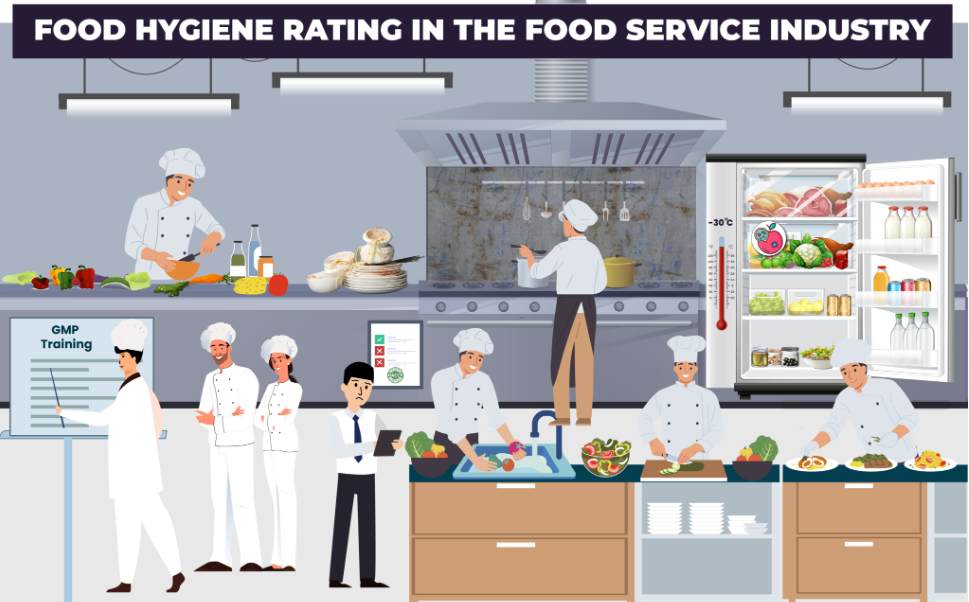
Manchester United’s food hygiene rating was downgraded from five to one due to a food safety incident that took place at the North West Safety Health Environment Show held on November 21, 2023, involving inappropriate cooking temperature monitoring, leading to raw chicken being served to 30 attendees.
This mishap underscores the notion that a food hygiene rating of 5 for an establishment does not necessarily mean a risk-free environment unless adequate protocols have consistently been followed to uphold the same. A comprehensive inspection regimen would have ensured meticulous checks to not only safeguard against food safety downfalls but also preserve the integrity of food hygiene standards.
Hence, maintaining a top-tier food hygiene rating reinforces the need for a strong commitment to all aspects contributing to ascertaining public health and safety, with a particular focus on rigorous inspection practices.
The Food Hygiene Rating Scheme (FHRS) is crafted to assess and convey the hygiene standards of food enterprises. Initially launched in the United Kingdom in 2010, this scheme has been embraced by numerous other nations since its introduction.
A food hygiene rating system evaluates and assigns scores to the cleanliness and sanitation practices of a food establishment and the overall operational protocols. Typically, the rating system employs a scale of 0 to 5, with 0 indicating the poorest hygiene standards and 5 representing the highest level of adherence to food safety protocols.
Here’s a brief overview of how the rating system operates, along with the corresponding points allocated to each rating:
Food hygiene rating 5: Classified as “Very Good” (0-15 points) – indicates a food establishment maintains and demonstrates exceptional hygiene standards.
Food hygiene rating 4: Classified as “Good” (20 points) – suggests there are some areas where improvements could be made.
Food hygiene rating 3: Classified as “Generally Satisfactory” (25-30 points) – denotes areas with potential for enhancement, though they typically do not present immediate health hazards.
Food hygiene rating 2: Classified as “Improvement Necessary” (35-40 points) – indicates notable areas where enhancements are needed.
Food hygiene rating 1: Classified as “Major Improvement Necessary” (45-50 points) – points out specific areas requiring immediate attention.
Food hygiene rating 0: Classified as “Urgent Improvement Necessary” (50+ points) – signifies substantial food hygiene concerns posing potential risks to public health.
The ratings are determined via the inspection of the following important facets, which include:
Food Handling: This aspect of the rating examines the handling of food, guaranteeing compliance with proper practices to prevent cross-contamination, maintaining optimal temperatures, and safely managing ingredients.
Food Storage: This segment consists of the proper storage of food, including refrigeration, stock rotation, and measures to protect against contamination and spoilage.
Food Preparation: Assessment of safe food preparation practices, such as complying with proper cooking temperatures, hygienic handling of ingredients, and prevention of bacterial growth or contamination during the preparation process.
Premise Hygiene: It involves the evaluation of the cleanliness and upkeep of kitchen areas, utensils, equipment, and dining spaces.
Food Safety Management: Consideration of the establishment’s management of food safety, including the presence of proper procedures, staff training, record-keeping, and effective implementation of food safety management systems.
A good food hygiene rating not only reflects positively on the establishment but also contributes to its success and reputation. Multiple measures can be enforced to improve food hygiene ratings, such as:
Staff Training and Education
Proper training and education of staff members on food hygiene practices are crucial.
Ensure all staff are aware of the importance of personal hygiene, including handwashing, proper clothing, and avoiding cross-contamination.
Regularly provide refresher courses and updates on food hygiene regulations.
Cleaning and Sanitization
Maintain a strict cleaning schedule for all areas of the establishment, including kitchen surfaces, equipment, and utensils.
Use appropriate cleaning agents and sanitizers to effectively eliminate bacteria and contaminants.
Regularly inspect and deep clean areas that are prone to buildup, such as refrigerators, ovens, and storage areas.
Temperature Control
Monitor and record temperatures of food storage units, refrigerators, freezers, and cooking equipment regularly.
Ensure that food is stored at the correct temperature to prevent bacterial growth and spoilage.
Food Handling and Storage
Implement proper food handling practices to prevent cross-contamination between raw and cooked foods.
Ensure that all food products are properly labeled, dated, and stored in correct containers to maintain freshness and prevent spoilage.
Pest Control
Develop and establish a robust pest control program to prevent infestations.
Regularly inspect the premises for signs of pests and take immediate action to address any issues.
Documentation and Record-Keeping
Maintain accurate records of food hygiene practices, including cleaning schedules, temperature logs, and staff training records.
Keep all documentation organized and readily available for inspection by food safety authorities.
Regular inspections and third-party audits provide valuable insights into areas needing improvement, thereby equipping food establishments to strengthen their hygiene practices by addressing any issues promptly through adequate corrective and preventive actions. Through feedback and recommendations obtained during inspections, food businesses can pinpoint operations requiring attention, whether it be updating protocols, investing in training programs, or upgrading equipment. Thus, thorough inspection processes can be instrumental in driving improvements in food hygiene ratings.
Augment your business’ food hygiene ratings with Smart Food Safe’s Smart Audit by overhauling inspection procedures through streamlining data collection, analysis, and reporting to bridge compliance gaps. It enables inspectors to effectively conduct inspections using digital forms on their devices. Smart Audit automates workflows, allowing for real-time tracking of inspection progress and assigning tasks accordingly. It also facilitates trend analysis and risk assessment by aggregating inspection data over time, helping identify patterns and areas for improvement. Furthermore, this digital solution generates intuitive reports with customizable metrics and visualizations, enabling stakeholders to make data-driven decisions, prioritize actions, and ensure compliance with food safety regulations effectively. Overall, by centralizing and automating inspection processes, Smart Audit enhances efficiency, transparency, and effectiveness in food safety inspections.
_1.png)